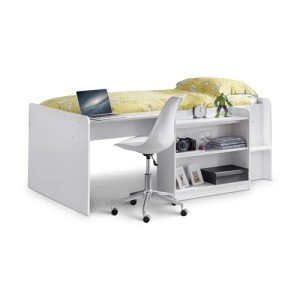The Ultimate Guide to Bunk Beds for Children: Safety, Styles, and Benefits
When it concerns styling a child's space, parents often deal with the dual challenge of making the most of space while ensuring convenience and functionality. Bunk beds have emerged as a popular solution that resolves these needs, using not just sleeping plans but likewise adding to a space's visual. In this comprehensive guide, we will delve into different aspects of kids's bunk beds, focusing on their advantages, safety features, styles, and factors to consider for moms and dads contemplating this purchase.
Tabulation
- Benefits of Bunk Beds
- Safety Features to Consider
- Types of Bunk Beds
- Style and Style Options
- Maintenance Tips
- Frequently Asked Questions (FAQs)
1. Benefits of Bunk Beds
Bunk beds use numerous benefits for kids and their parents. Here are some crucial advantages:
- Space-Efficiency: Bunk beds are an outstanding option for smaller sized rooms. By stacking one bed on top of another, more floor space is readily available for play, storage, or research study areas.
- Cost-Effective: When kids share rooms, bunk beds can decrease the requirement for acquiring 2 different beds, hence saving money.
- Promotes Social Interaction: Bunk beds can assist siblings or good friends bond by sharing a space, creating chances for social development.
- Enjoyable Factor: The idea of sleeping "up high" includes a lively element to bedtime, making the shift to sleeping alone much easier for some kids.
- Versatile Design: Bunk beds can be found in various styles, colors, and creates to match any room style, permitting customization that shows the kid's character.
2. Security Features to Consider
Security is paramount when it pertains to children's furniture, specifically in the case of bunk beds. Here are some critical security features to evaluate:
| Safety Feature | Description |
|---|---|
| Sturdy Construction | Frames made of strong wood or metal are preferred. |
| Guardrails | Need to be at least 5 inches high and extend along both sides of the upper bunk. |
| Ladder Design | Guarantee ladders are firmly connected and have non-slip actions. |
| Bed mattress Size & & Fit | Need to fit snugly within the frame to prevent spaces. |
| Weight Limit | Constantly adhere to the maker's weight limitation recommendations. |
3. Types of Bunk Beds
Bunk beds can be found in a number of styles, accommodating various needs, preferences, and space sizes. Here are some common types:
- Standard Bunk Bed: The most standard type, with one bed on top of another.
- Loft Bed: Features a high upper bed with space below for a desk or play location.
- Futon Bunk Bed: Combines a top bunk with a futon on the bottom, supplying flexibility for seating and sleeping.
- L-Shaped Bunk Bed: This design has the top bunk set at a perpendicular angle to the bottom, producing a small corner area.
- Triple Bunk Bed: Accommodates 3 children using stacked beds, perfect for large households or pajama parties.
4. Style and Style Options
When it pertains to picking a design for kids's bunk beds, the options are practically endless. Here are some popular designs:
- Traditional Style: Often made from wood, these bunk beds feature ornate details and are ideal for classic or rustic-themed rooms.
- Modern Style: Characterized by clean lines and minimalist designs, modern-day bunk beds can be made from metal or wood.
- Themed Bunk Beds: Some brands offer bunk beds formed like castles, vehicles, or play houses, making bedtime less of a task.
- Convertible Bunk Beds: These can be separated into two individual beds, providing versatility as children grow.
- Colorful Options: Bunk beds in lively colors can include a sense of pleasure and playfulness to any room.
5. Maintenance Tips
Keeping a bunk bed is vital for durability and safety. Here are some pointers:
- Regular Inspections: Check for loose screws or bolts every few months and tighten them as needed.
- Cleaning up: Wipe down frames regularly to prevent dust accumulation; consider using a vacuum for hard-to-reach areas.
- Bed mattress Care: Rotate mattresses frequently and use protective covers to prolong their life.
- Expect Wear and Tear: Look for any signs of damage in the wood or metal and think about replacing parts if required.
- Teach Kids Safety Rules: Encourage children to use ladders appropriately and ensure they understand the safety features of their bed.
6. Frequently Asked Questions (FAQs)
Q1: What age is suitable for oversleeping a top bunk?
A1: Typically, children aged 6 and older are recommended for upper bunk sleeping, as they have the necessary motor abilities to climb safely.
Q2: Do bunk beds feature a bed mattress?
A2: Most bunk beds are offered as frames only, so you will require to purchase mattresses separately. Make sure that the bed mattress fits the frame comfortably.
Q3: Can bunk beds be separated later?
A3: Many styles allow conversion into 2 private beds, providing flexibility for future requirements.
Q4: How can I ensure my kid's safety on a bunk bed?
A4: Comply with safety requirements and make sure guardrails, a sturdy frame, and a protected ladder are in location.
Q5: Are there weight limitations on bunk beds?
A5: Yes, always examine the maker's requirements regarding weight limits to guarantee safety.
Bunk beds for children can serve multiple purposes while ensuring security and design. With diverse styles and designs available on the marketplace, moms and dads can discover an unit that not only takes full advantage of bed room space but also reflects their kid's unique tastes. Bunk Bed Sales to any furniture, comprehending safety features, upkeep, and how they fit into a kid's lifestyle will guarantee that these beds stay a useful furniture option for years to come.
Through mindful consideration and adherence to safety guidelines, bunk beds can offer a long-lasting, fun, and functional sleeping option that kids love.

